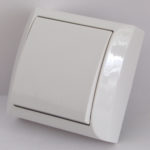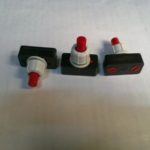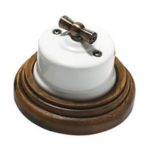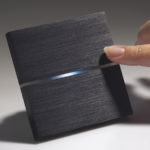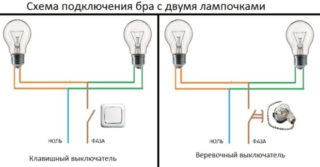Lighting fixtures in the form of wall sconces have an interesting design. The decorative effect is enhanced by unusual ways of connecting them. So, a switch for a sconce can be in the form of a touch panel, a cord, a keyboard device, etc. You can choose an electrical element for the general style of the room.
Types of switches for lamps and sconces
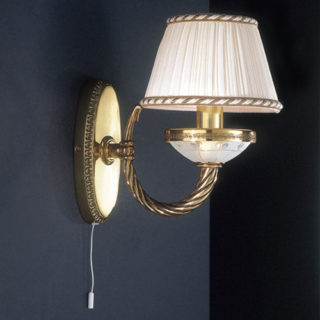
All such wiring elements are classified according to several parameters. According to the fastening technique, they are distinguished:
- external (overhead), which are mounted without cutting into the wall;
- internal (built-in), requiring panel chasing.
According to the method of connecting the switches for the lamp, the following elements are distinguished:
- With screwless clamps. They are quick and easy to install, the wires in the terminals are held securely.
- With screw terminals. A less reliable element, in which the terminals periodically weaken. We have to regularly tighten them up.
Electrical installation elements also differ according to the method of switching on:
- Key. The most familiar type of switch for all. It can be one-, two-, three-key. Thanks to this design, it is possible to control individual bulbs in the luminaire.
- Button. The lighting device actuates the mechanism from the spring of the movable contact. As a result of the action on the button, the electrical circuit is closed and opened. A striking example of a push-button element is a switch on a sconce wire. Luminaires are often already equipped with them.
- Switch with chain or rope. This type of element works on the principle of push-button elements. When the cord is pulled for the first time, the circuit is closed (the lamp is on). Re-tensioning the chain will open the chain (the lamp goes out). A switch for a sconce with a chain or string is convenient to use and performs an additional decorative function.
- Turning. Externally resembles a toggle switch that can be moved up / down or right / left. This element is used to create retro designs.
- Sensory. It is based on microcircuits. The main difference from all previous models is the complete absence of protruding parts on the panel (buttons, keys, toggle switches). The switch reacts to the movement of the palm. Additionally, sensor elements can react to temperature, light level.
In mechanisms with electrical circuits, it is possible to block the operation of the sensors if necessary.
The entrance switch for the sconce does not differ in any way from the keyboard switch, but at the same time it is able to transfer power from one circuit to another. When an opening occurs in one section of the network, the next section of it immediately closes. Such elements are especially good for narrow extended rooms (corridor, hallway, etc.). Pass-through switches are single, double and even three-key.
Options for connecting a sconce through a switch
- Through wall element (internal). The wiring to the luminaire runs in grooves or cable ducts. Under the switch, you need to make a special socket, into which the glass is first put, and then the wiring element itself. The strobes need to be done before finishing the walls. If the repair has already been completed, the wiring is carried out parallel to the baseboard and then to the lamp.
- Direct connection to the electrical network of the house. This is how they mount switches for sconces with a chain or rope.In this case, the closing and opening mechanism itself is located in the luminaire. Such devices are arranged by attaching a special plate to the wall, into which the cable wires are led out. Twist the conductors together according to the colors or markings - L for phase, N - for zero, PE - grounding.
- Connection with a standard plug. In this case, the lamp is simply plugged into the socket. To carry out the work, you just need to finish the sconce cable with an additional current guide with a plug at the end.
The connection method is chosen depending on the circumstances: the presence or absence of finishing, a nearby outlet, etc.
Mounting a sconce with a rope switch
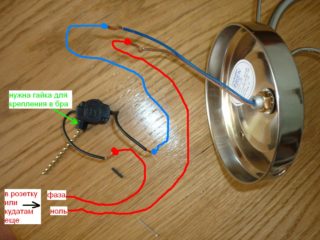
The chain switch is installed as follows:
- Markings are applied to the wall for the installation of the future lamp. These are just two points, spaced apart from each other in accordance with the technical clearances on the back of the fixing bar.
- To avoid the fall of construction dust on the floor, you can attach a plastic bag under the markings to the adhesive tape.
- Drill holes with a puncher. Dowels are driven into them.
- Now you need to screw on the fixing strip. It is important to tighten the nails well.
- From the groove, a cable is brought to the plate in order to connect it later to the lighting device.
- On the luminaire body in the lower part of it, you need to make a mark strictly in the center. An 8 mm hole is drilled here for the outlet of the lanyard switch for the sconce. There is a button at one end of it, which will work as a hidden circuit opening / closing stimulator. The main thing is not to exceed the cross-section of the clamping ring, which acts as a breaker lock.
- A chain is passed into the finished hole and the button is clamped using the above-mentioned bolt (nut).
- When connecting wires, the phase must always be connected to turn off. Thus, if a finger accidentally gets into an empty cartridge, a person does not get injured. In Soviet apartments, this rule was often neglected, and an electrical discharge could be generated when a hand touched a light bulb.
- With the help of vag the wires are connected. The brown phase cable is connected to the off button. The blue wire at 0 is connected to the wiring in the wall, and the second wire from the button (to turn on) is connected to the phase cable here. Using an indicator screwdriver, check the power supply.
- The base of the lamp is mounted on the plate, to which the cord switch for the sconce is already connected.
- It remains to screw a light bulb into the lamp holder and put on the plafond.
- They pull the string and see a full-fledged graceful backlight after correct connection.
It is advisable to carry out all work only after the apartment / house is completely de-energized.

